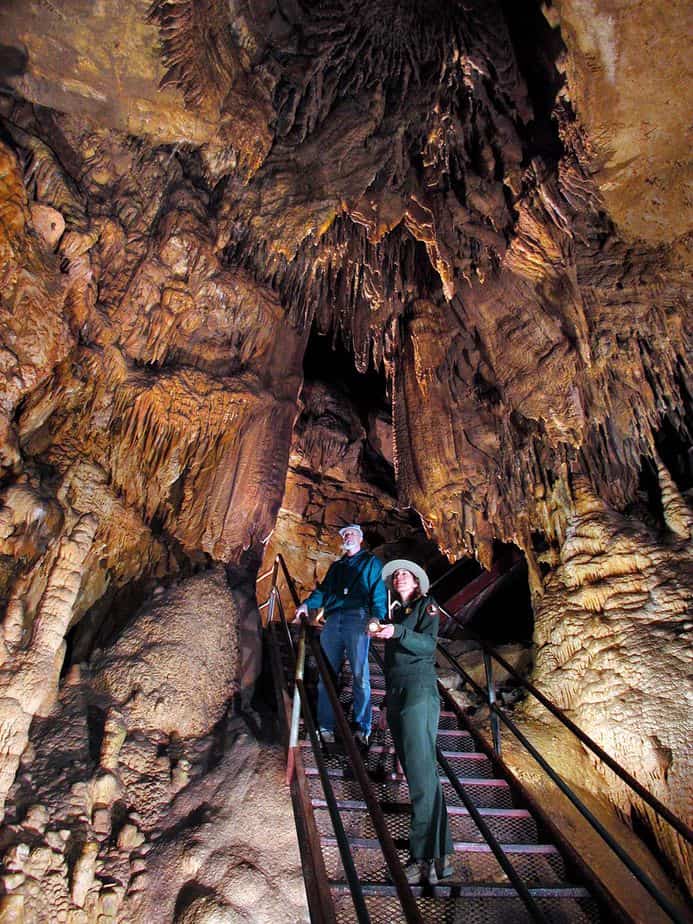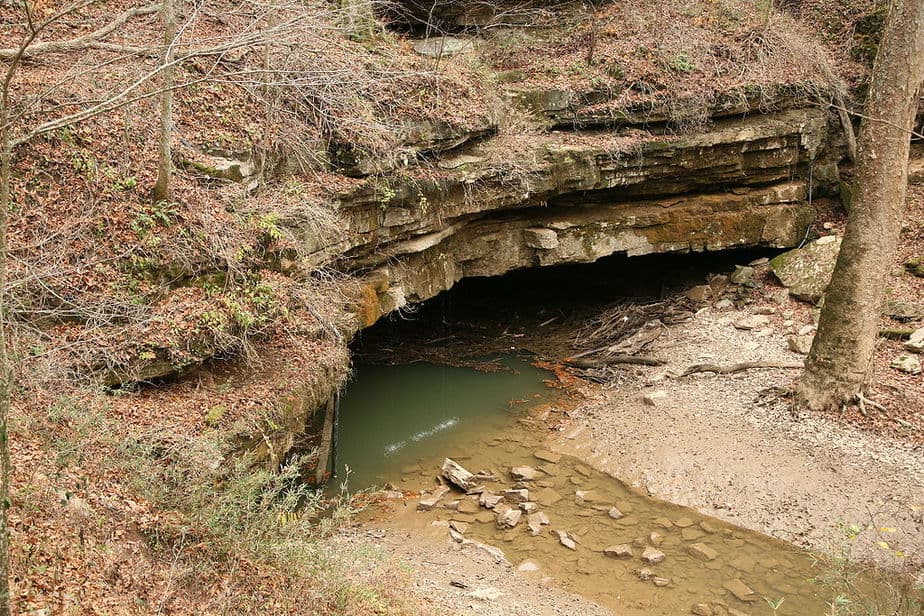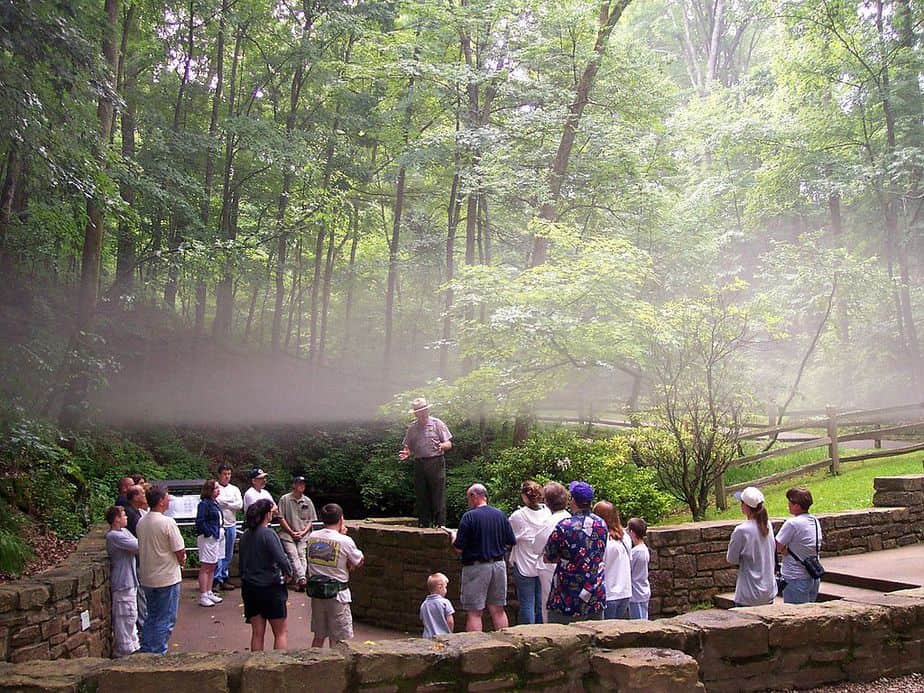Top 10 Surprising Facts about the Mammoth Cave National Park

Mammoth Cave National Park by National Park Service Digital Image Archives from Wikimedia Commons
A large network of sinkholes, springs, streams, and cave systems lies beneath the surface of south-central Kentucky, contributing to the formation of some of the world’s most important karst ecosystems.
Mammoth Cave National Park is a UNESCO World Heritage Site as well as an International Biosphere Reserve, helping to preserve a dramatic, complex ecosystem that includes over 400 caves and an impressive diversity of terrestrial and aquatic organisms, including those that have evolved to live in dark, cavernous environments.
Learn more about Mammoth Cave National Park with these ten mind-blowing facts.
1. Mammoth Cave’s oldest parts are at least 10 million years old

River Styx by Daniel Schwen from Wikimedia Commons
Although the rock beds are thought to have developed around 320 to 360 million years ago during the Mississippian Period, the cave’s main tunnels did not begin to form until between 10 and 15 million years ago.
These pathways were formed when surface rivers and streams carried water down into the subterranean rock beds through small fissures, where it remained until contemporary times, continuing to flow into the cave and lower levels (the cave is still forming today).
2. It protects the longest cave system on the planet

Mammoth Cave from National Park Service Digital Image Archives from Wikimedia Commons
Mammoth Cave National Park not only protects the world’s longest known cave system, but it’s also nearly twice as long as the world’s second-longest cave (the underwater Sac Actun cave in Mexico).
At Mammoth, explorers have already mapped out over 412 miles of the underground route, however, new passages are still being discovered—some experts say the cave system might be as much as 200 miles longer.
3. It protects the longest cave system on the planet
In 1981, UNESCO designated Mammoth Cave National Park as a World Heritage Site, mostly owing to the fact that the park has practically every type of cave formation. Not only that, but Mammoth Cave’s flora and fauna are the richest cave-dwelling animals known to man, with over 130 species found in just the cave system.
The network of cave channels helps offer researchers a perfectly accessible record of the world’s geomorphic and climatic changes since it demonstrates 100 million years of cave-forming activity.
4. An Endangered Cave Shrimp Found Nowhere Else on Earth Lives in the Cave System
Mammoth Cave National Park is home to more than caverns; it also has various forest environments and diverse flora and fauna. Over 1,300 blooming plant species and a diverse range of bird species, including bald eagles and wood warblers, may be found in the surrounding woodland. The park has a total of 52,830 acres of wilderness, including 60 miles of backcountry hiking paths and 30 miles of waterways.
5. 5,000 Years Ago, Native Americans mined the caves
Native American exploration was documented between 5,000 and 4,000 years ago, thousands of years before European people arrived. Early residents of the region extracted minerals from Mammoth Cave’s corridor, scraping the soft natural chemicals from the cave’s walls into containers with mussel shells from the neighbouring Green River. There are also prehistoric petroglyphs and pictographs drawn with charcoal pigment in some parts of the cave.
6. The Paleozoic and Cenozoic periods are preserved at Mammoth Cave
Some of the sedimentary bedrock strata that make up the Mammoth Cave formations are Paleozoic limestone, sandstones, and shales that date back 300 to 325 million years.
Because the limestone originated at the bottom of the Mississippian Sea, its fossils typically comprise sea species from the Mississippian Period. As a result, corals, crinoids, brachiopods, gastropods, and even sharks fossils can be found embedded in cave walls.
On top of the limestone strata, Pennsylvanian Period sandstone and shale generate ancient plant fossils, and certain cave sinkhole openings include animal fossil bones deposited between 2 million and 5 million years ago.
7. Mammoth Cave National Park was established with the help of a local community group
The Mammoth Cave National Park Association was founded in 1924 by a group of Kentucky residents with the goal of creating a national park. Mammoth Cave National Park was established in 1941 after years of lobbying the National Park Service, collecting property, and constructing the necessary infrastructure.
8. Aquifers in Mammoth Caves Aid in the Provision of Drinking Water to the US Population
Over 4,900 caves and karst formations (limestone landscapes that have deteriorated to generate sinkholes, caverns, and subterranean streams) are managed by the US National Park Service, the greatest of which is found in Mammoth Cave National Park.
Karst formations are significant because they contain aquifers that absorb natural rainwater underground; while covering just 20% of the country, their aquifers carry around 40% of the country’s groundwater.
9. Enslavement afflicted many of the park’s greatest explorers
From the mining of saltpeter (the main ingredient in gunpowder) within the depths of Mammoth during the War of 1812 to the establishment of the popular tourist destination before the Civil War, enslaved Black people played a role in practically every aspect of the cave system’s original rediscovery by modern man.
Many of these men and women worked as cleaners and cooks at the Mammoth Cave Hotel, while others served as tour guides to assist guests to construct tour itineraries within the caverns. Until his death in 1857, one of the most well-known, a self-educated enslaved man named Stephen Bishop, served as both a guide and an explorer, contributing to many of the cave’s most noteworthy discoveries.
10. An endangered cave shrimp found nowhere else on earth lives in the Cave System

Mammoth Cave National Park by National Park Service Digital Image Archives from Wikimedia Commons
The Kentucky cave shrimp (Palaemonias ganteri) is a tiny, endangered crustacean that reaches a length of little over an inch. They are one of just two known species of the genus Palaemonias, with transparent bodies and no eyes. Kentucky cave shrimp have only been seen in underground streams in and around Mammoth Cave National Park, and are only found in the state of Kentucky. In 1983, the US Fish and Wildlife Service identified a solitary stream in a base-level cave channel in Mammoth Cave as vital shrimp habitat.
Many various tours and cave entrances are available in Mammoth Cave National Park, including the traditional entry (walking trail) and elevator access. There are kilometres of pathways in the caverns.
Self-guided tours are the most popular, but you may also discover particular topic excursions such as geology, historic tours, and off-trail experiences. Some trips have been cancelled due to Covid-19, and bookings are strongly advised at all times. NPS.gov has all of the most up-to-date information.
Planning a trip to Paris ? Get ready !
These are Amazon’s best-selling travel products that you may need for coming to Paris.
Bookstore
- The best travel book : Rick Steves – Paris 2023 – Learn more here
- Fodor’s Paris 2024 – Learn more here
Travel Gear
- Venture Pal Lightweight Backpack – Learn more here
- Samsonite Winfield 2 28″ Luggage – Learn more here
- Swig Savvy’s Stainless Steel Insulated Water Bottle – Learn more here
Check Amazon’s best-seller list for the most popular travel accessories. We sometimes read this list just to find out what new travel products people are buying.










